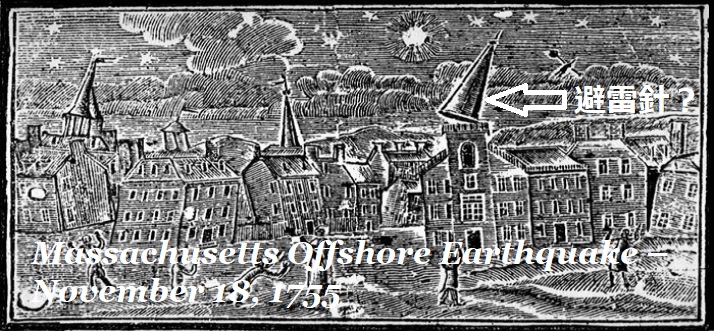
レッキー(Lecky,William Edward Hartpole, 1838-1903)は,魔女術の問題を彼の「合理主義の歴史」の中で詳細に扱っており,ブラック・マジック(黒魔術/黒呪術)に対する信仰はこの問題に関する論証によってでなく,法の支配に対する信仰の普及により打ち負かされた,という興味深い事実を指摘した(している)。彼は魔女術に関する詳細な議論において,論証の重み(づけ)は魔女術(が存在すること)を支持している者の側にあるとさえ主張しているほどである(even goes so far as to say )。このことは,もしかすると,魔女術(の存在)を支持する者たちが聖書を引用しうるのに反し,反対者たち(魔女術の存在を否定する人たち)が聖書の全てを例外なく信ずるべきではない(常に信ずるべきということではない)とあえて主張することはできなかったことを想起すれば,驚くにあたらないことかも知れない。さらに,すぐれた科学的精神の持主たちが通俗的な迷信に関わらなかったのは,ひとつには彼らがもっと積極的な(前向きな)仕事を持っていたからであり,一つには彼らが敵意を喚起するのを恐れたからであった。この出来事(the event)は彼ら(科学的精神の持ち主たち)は正しかったことを示している。ニュートンの著作は,神は最初に自然を創造し,そうしてキリスト教の啓示のような重大な機会以外は(神が)新たに介入することなく神が意図した結果を自然法則が生み出すように命じたのだ,と人々を信じさせた。プロテスタントは,(神による)奇蹟は西暦1世紀あるいは西暦2世紀に起ったが,その後は止んだのだと考えた。もし,神が奇蹟による介入をしないなら,悪魔にも奇蹟を起こすことを(神が)許すということはほとんど考えられなかった。科学的な気象学についての期待が存在しており,科学的気象学はもはや嵐の原因としてのほうきに乗った老女の存在などを認める余地はなかったであろう。しばらくの間,雷光や雷音に自然法則の概念を適用することは(神に対する)不敬であるとずっと考えられていた。それらは神が特別になさることであるという理由からであった。この見解は,避雷針対する抵抗(反対)のなかに生き残った。そうして,1755年にマサチュセッツが地震で揺れた時,尊師プライス博士は,本になって出た説教の中で(in a published sermon),それらの地震は「聡明なるフランクリン氏(注:Benjamin Franklin, 1706- 1790:米国の政治家で気象学者)により発明された鉄針」のせいだとして,次のように言っている。「ボストンではニューイングランドの他のどこよりも(避雷針が)多く立っているので,ポストンは他のどこよりも恐ろしく揺れたように思われる。おお! 全能の神の御手から逃げ出すことはまったくできない(のだ)」。この警告にも関らず,ポストンの人々は「鉄針」を立て続けたが,地震(発生)の頻度は増加はしなかった。 ニュートンの時代以後,プライス博士のような観点はますます迷信的香りがするように感じられるようになった。そうして,自然の行程への奇蹟による干渉への信仰は死に絶え,魔女術の可能性に対する信仰もまた必然的に消滅した。魔女術の証拠は決して反証されることはなかった。ただ,魔女術の証拠を吟味する価値があると思われなくなったのである。
Chapter 4: Demonology and Medicine, n.16
Lecky, whose History of Rationalism deals at length with the subject of witchcraft, points out the curious fact that belief in the possibility of black magic was not defeated by arguments on this subject, but by the general spread of belief in the reign of law. He even goes so far as to say that, in the specific discussion of witchcraft, the weight of argument was on the side of its upholders. This is perhaps not surprising when we remember that the Bible could be quoted by the upholders, while the other side could hardly venture to say that the Bible was not always to be believed. Moreover, the best scientific minds did not occupy themselves with popular superstitions, partly because they had more positive work to do, and partly because they feared to rouse antagonism. The event showed that they were right. Newton’s work caused men to believe that God had originally created nature and decreed nature’s laws so as to produce the results that He intended without fresh intervention, except on great occasions, such as the revelation of the Christian religion. Protestants held that miracles occurred during the first century or two of the Christian era, and then ceased. If God no longer intervened miraculously, it was hardly likely that He would allow Satan to do so. There were hopes of scientific meteorology, which would leave no room for old women on broomsticks as the causes of storms. For some time it continued to be thought impious to apply the concept of natural law to lightning and thunder, since these were specially acts of God. This view survived in the opposition to lightning conductors. Thus when, in 1755, Massachusetts was shaken by earthquakes, the Rev. Dr. Price, in a published sermon, attributed them to the “iron points invented by the sagacious Mr. Franklin,” saying : “In Boston are more erected than elsewhere in New England, and Boston seems to be more dreadfully shaken. Oh! there is no getting out of the mighty hand of God.” In spite of this warning, the Bostonians continued to erect the “iron points,” and earthquakes, nevertheless, did not increase in frequency. From the time of Newton onward, such a point of view as that of the Rev. Dr. Price was increasingly felt to savour of superstition. And as the belief in miraculous interference with the course of nature died out, the belief in the possibility of witchcraft necessarily also disappeared. The evidence for witchcraft has never been refuted ; it has simply ceased to seem worth examining.
出典:Religion and Science, 1935, chapt. 4:
情報源:https://russell-j.com/beginner/RS1935_04-160.HTM
